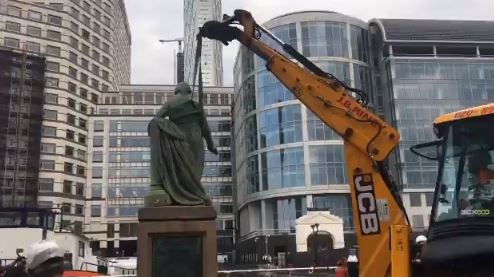London: The statue of prominent British slave trader Robert Milligan, who owned sugar plantations and slaves in 18th century Jamaica, has been removed from its site at West India Quay in London as part of an ongoing review triggered by the British capital’s recent Black Lives Matter protests.
The local Tower Hamlets Council said it had launched its own review for the local borough to reassess how ‘troubling’ aspects of the city’s history should be addressed.
“We have removed the statue of slave trader Robert Milligan that previously stood at West India Quay. We have also announced a review into monuments and other sites in our borough to understand how we should represent the more troubling periods in our history,” the council said.
Tonight, we have removed the statue of slave trader Robert Milligan that previously stood at West India Quay. We have also announced a review into monuments and other sites in our borough to understand how we should represent the more troubling periods in our history. pic.twitter.com/Thfz3UHU96
— Tower Hamlets Council (@TowerHamletsNow) June 9, 2020
The action followed dramatic scenes of another statue of a former slave trader, Edward Colston, being pulled down by demonstrators in the city of Bristol while protesting over the weekend against the killing of 46-year-old African-American George Floyd in the US.
An online petition for the removal of a statue of Robert Clive in western England for his role in India’s colonisation has also attracted over 6,000 signatures within days.
Acknowledging public anger, London Mayor Sadiq Khan had announced a new Commission for Diversity in the Public Realm to review the UK capital’s landmarks with a view to increase representation among Black, Asian and Minority Ethnic (BAME) communities, women, the LGBTQ+ community and disability groups.
“The statue of slave trader Robert Milligan has now been removed from West India Quay. It’s a sad truth that much of our wealth was derived from the slave trade – but this does not have to be celebrated in our public spaces,” Khan said.
There were cheers and clapping as the monument was lifted from its plinth using a crane on Tuesday evening.
The Museum of London Docklands said the statue of Milligan, who owned two sugar plantations and 526 slaves in Jamaica, had ‘stood uncomfortably’ outside its premises ‘for a long time’.
“The Museum of London recognises that the monument is part of the ongoing problematic regime of white-washing history, which disregards the pain of those who are still wrestling with the remnants of the crimes Milligan committed against humanity,” it said.
The Canal and River Trust said it had worked with the London Borough of Tower Hamlets, the museum and partners in Canary Wharf to have it removed.
There is a growing movement against statues reflecting Britain’s dubious slave trading and colonial past, with an Indian-origin councillor from the region of Shropshire among those leading the calls for the removal of Shropshire-born “Clive of India” statue in the county.
“Robert Clive looted and plundered India while he was there working for the East India Company around the 1750s,” said Kuldip Sahota, backing the thousands of signatories to a petition against the sculpture in Shrewsbury town centre.
The scene he created there was one of anarchy, bribery, corruption and extortion on the scale never seen or heard of before, he said.
“When some years later the British government heard of his and the East India’s antics, even they were unhappy with his conduct. British historian William Dalrymple called him an ‘unstable sociopath’.
“Therefore, his statue should be removed from our county town and put in a museum,” Sahota said.
Elsewhere, thousands of Oxford University students staged a sit-in protest outside Oriel College demanding the removal of a sculpture of colonialist Cecil Rhodes.
Susan Brown, the Leader of Oxford City Council, has written to the University of Oxford “inviting” it to apply for planning permission to remove a statue of Rhodes from his alma mater.
Governors at Oriel College said that the institution ‘abhors racism and discrimination in all its forms’, but that the college was continuing to ‘debate and discuss’ the presence of the Rhodes statue.
PTI
